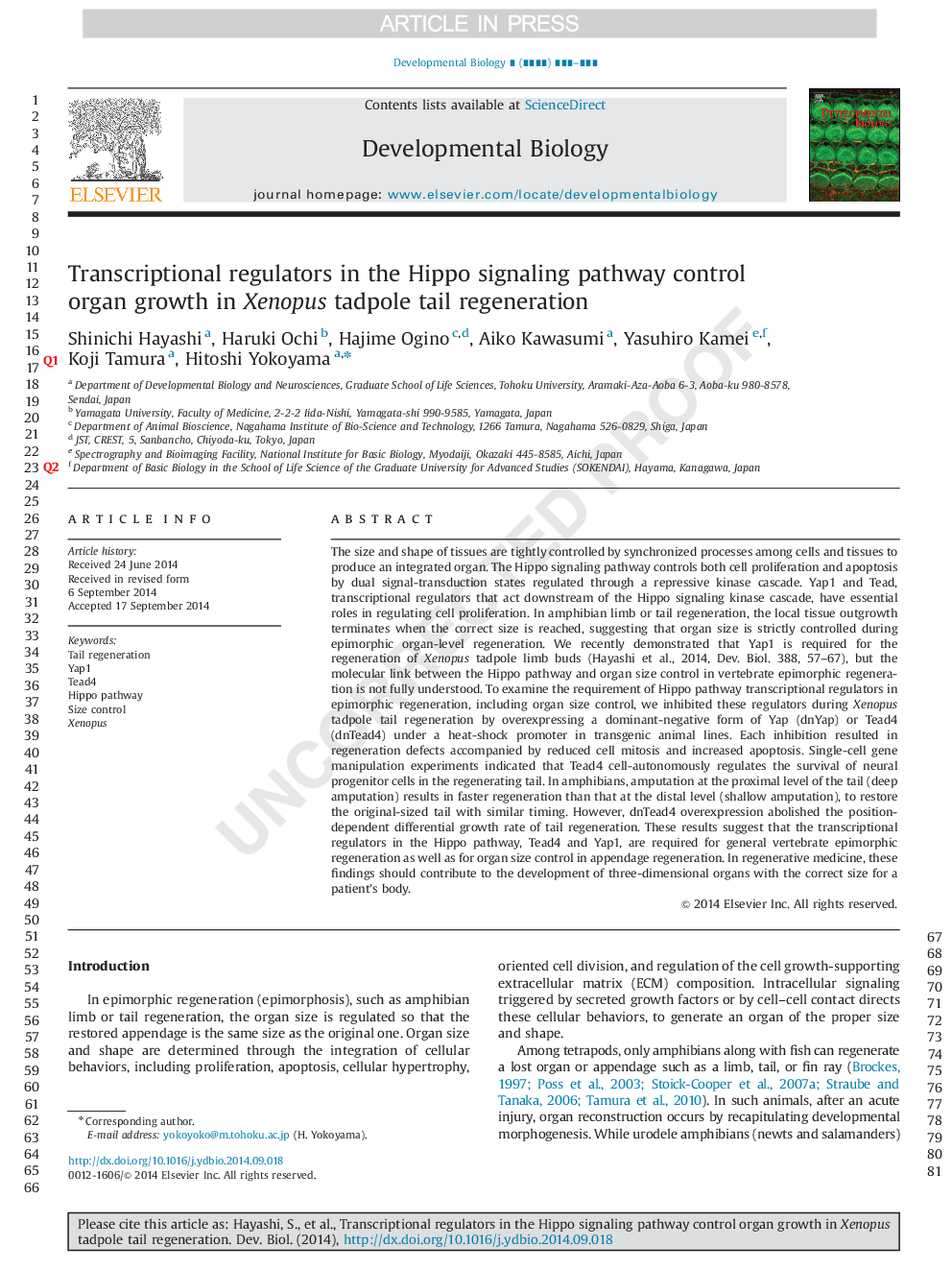| کد مقاله | کد نشریه | سال انتشار | مقاله انگلیسی | نسخه تمام متن |
|---|---|---|---|---|
| 10931707 | 1093665 | 2014 | 11 صفحه PDF | دانلود رایگان |
عنوان انگلیسی مقاله ISI
Transcriptional regulators in the Hippo signaling pathway control organ growth in Xenopus tadpole tail regeneration
دانلود مقاله + سفارش ترجمه
دانلود مقاله ISI انگلیسی
رایگان برای ایرانیان
کلمات کلیدی
موضوعات مرتبط
علوم زیستی و بیوفناوری
بیوشیمی، ژنتیک و زیست شناسی مولکولی
بیولوژی سلول
پیش نمایش صفحه اول مقاله

چکیده انگلیسی
The size and shape of tissues are tightly controlled by synchronized processes among cells and tissues to produce an integrated organ. The Hippo signaling pathway controls both cell proliferation and apoptosis by dual signal-transduction states regulated through a repressive kinase cascade. Yap1 and Tead, transcriptional regulators that act downstream of the Hippo signaling kinase cascade, have essential roles in regulating cell proliferation. In amphibian limb or tail regeneration, the local tissue outgrowth terminates when the correct size is reached, suggesting that organ size is strictly controlled during epimorphic organ-level regeneration. We recently demonstrated that Yap1 is required for the regeneration of Xenopus tadpole limb buds (Hayashi et al., 2014, Dev. Biol. 388, 57-67), but the molecular link between the Hippo pathway and organ size control in vertebrate epimorphic regeneration is not fully understood. To examine the requirement of Hippo pathway transcriptional regulators in epimorphic regeneration, including organ size control, we inhibited these regulators during Xenopus tadpole tail regeneration by overexpressing a dominant-negative form of Yap (dnYap) or Tead4 (dnTead4) under a heat-shock promoter in transgenic animal lines. Each inhibition resulted in regeneration defects accompanied by reduced cell mitosis and increased apoptosis. Single-cell gene manipulation experiments indicated that Tead4 cell-autonomously regulates the survival of neural progenitor cells in the regenerating tail. In amphibians, amputation at the proximal level of the tail (deep amputation) results in faster regeneration than that at the distal level (shallow amputation), to restore the original-sized tail with similar timing. However, dnTead4 overexpression abolished the position-dependent differential growth rate of tail regeneration. These results suggest that the transcriptional regulators in the Hippo pathway, Tead4 and Yap1, are required for general vertebrate epimorphic regeneration as well as for organ size control in appendage regeneration. In regenerative medicine, these findings should contribute to the development of three-dimensional organs with the correct size for a patient's body.
ناشر
Database: Elsevier - ScienceDirect (ساینس دایرکت)
Journal: Developmental Biology - Volume 396, Issue 1, 1 December 2014, Pages 31-41
Journal: Developmental Biology - Volume 396, Issue 1, 1 December 2014, Pages 31-41
نویسندگان
Shinichi Hayashi, Haruki Ochi, Hajime Ogino, Aiko Kawasumi, Yasuhiro Kamei, Koji Tamura, Hitoshi Yokoyama,